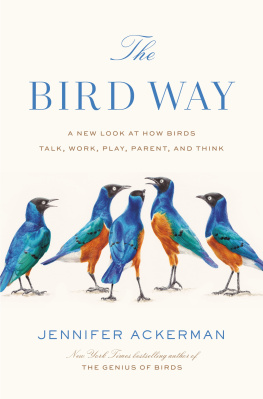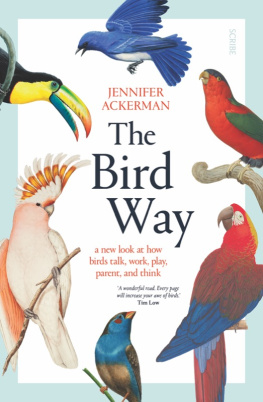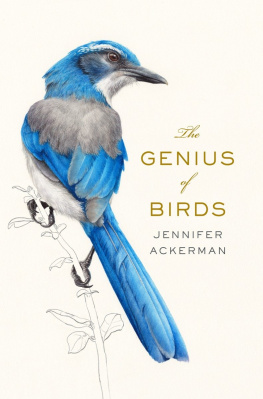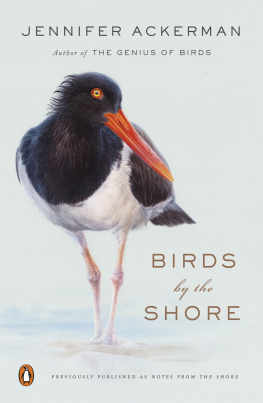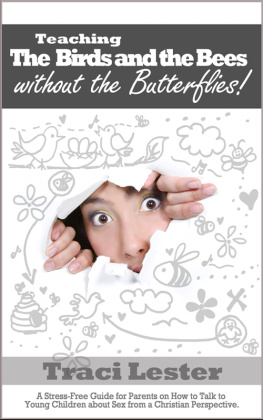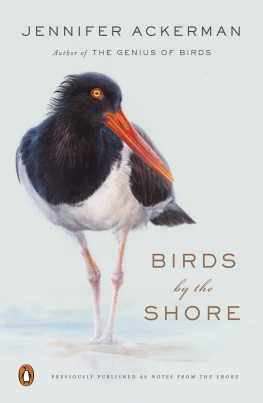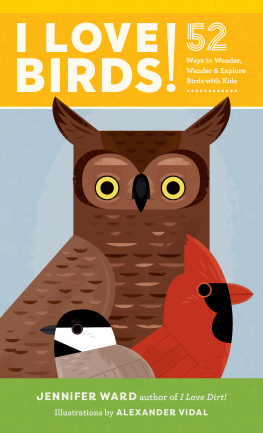Jennifer Ackerman - A New Look at How Birds Talk, Work, Play, Parent, and Think
Here you can read online Jennifer Ackerman - A New Look at How Birds Talk, Work, Play, Parent, and Think full text of the book (entire story) in english for free. Download pdf and epub, get meaning, cover and reviews about this ebook. year: 2020, publisher: Penguin Publishing Group, genre: Science. Description of the work, (preface) as well as reviews are available. Best literature library LitArk.com created for fans of good reading and offers a wide selection of genres:
Romance novel
Science fiction
Adventure
Detective
Science
History
Home and family
Prose
Art
Politics
Computer
Non-fiction
Religion
Business
Children
Humor
Choose a favorite category and find really read worthwhile books. Enjoy immersion in the world of imagination, feel the emotions of the characters or learn something new for yourself, make an fascinating discovery.
- Book:A New Look at How Birds Talk, Work, Play, Parent, and Think
- Author:
- Publisher:Penguin Publishing Group
- Genre:
- Year:2020
- Rating:4 / 5
- Favourites:Add to favourites
- Your mark:
- 80
- 1
- 2
- 3
- 4
- 5
A New Look at How Birds Talk, Work, Play, Parent, and Think: summary, description and annotation
We offer to read an annotation, description, summary or preface (depends on what the author of the book "A New Look at How Birds Talk, Work, Play, Parent, and Think" wrote himself). If you haven't found the necessary information about the book — write in the comments, we will try to find it.
A New Look at How Birds Talk, Work, Play, Parent, and Think — read online for free the complete book (whole text) full work
Below is the text of the book, divided by pages. System saving the place of the last page read, allows you to conveniently read the book "A New Look at How Birds Talk, Work, Play, Parent, and Think" online for free, without having to search again every time where you left off. Put a bookmark, and you can go to the page where you finished reading at any time.
Font size:
Interval:
Bookmark:
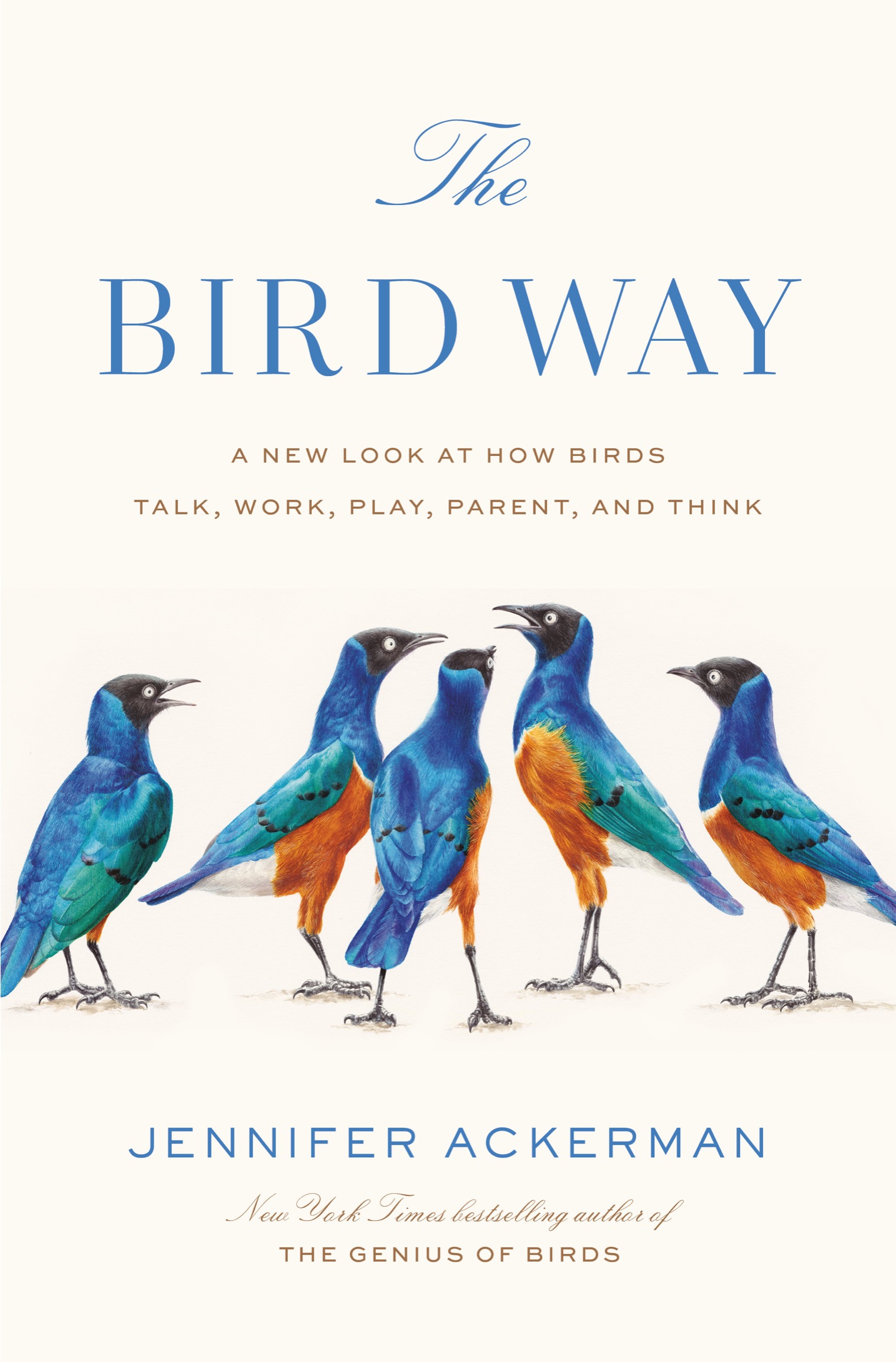
The Genius of Birds
Sex Sleep Eat Drink Dream: A Day in the Life of Your Body
Ah-Choo!: The Uncommon Life of Your Common Cold
Chance in the House of Fate: A Natural History of Heredity
Birds by the Shore: Observing the Natural Life of the Atlantic Coast
(previously published as Notes from the Shore)
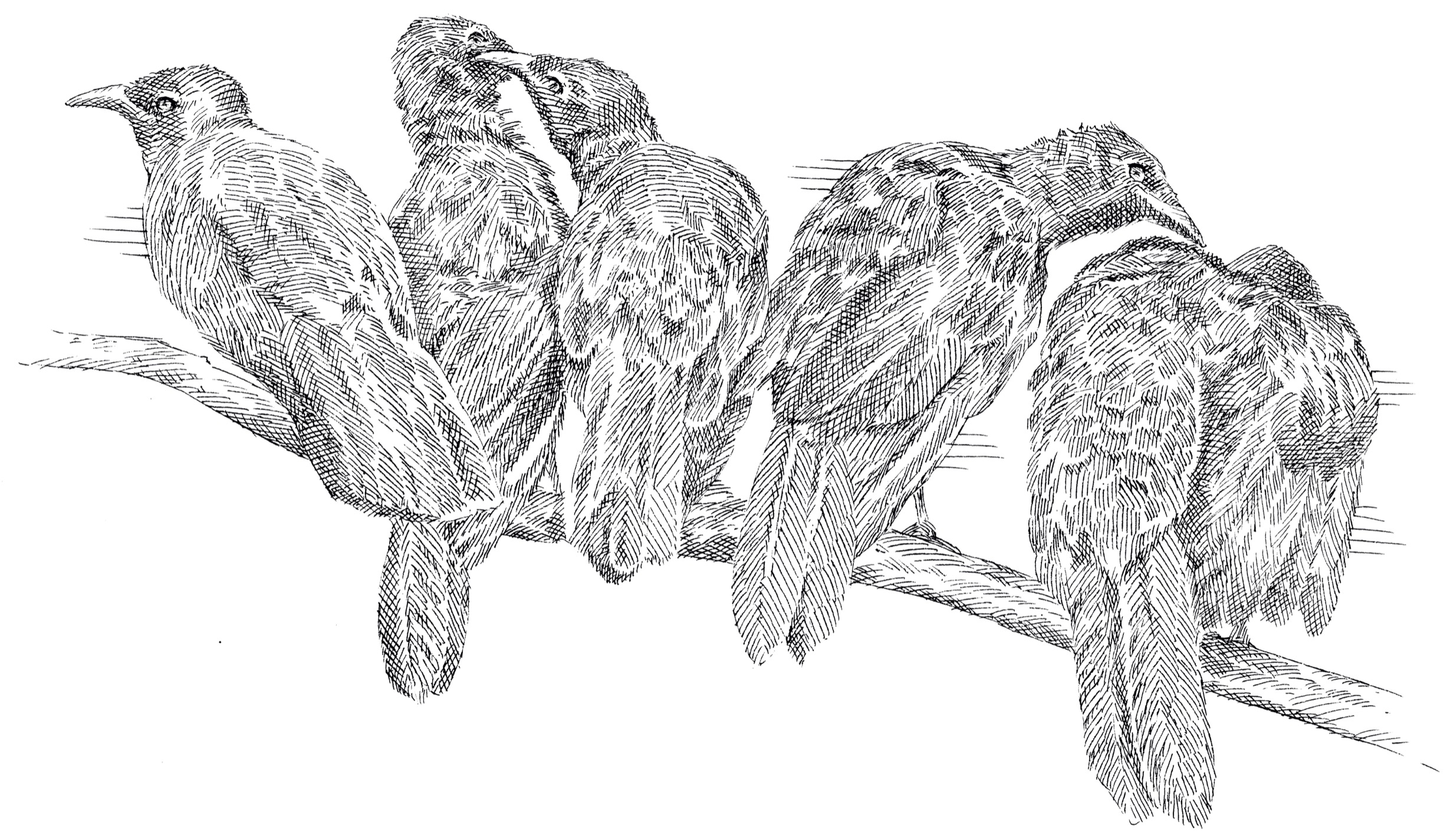

PENGUIN PRESS
An imprint of Penguin Random House LLC
penguinrandomhouse.com
Copyright 2020 by Jennifer Ackerman
Penguin supports copyright. Copyright fuels creativity, encourages diverse voices, promotes free speech, and creates a vibrant culture. Thank you for buying an authorized edition of this book and for complying with copyright laws by not reproducing, scanning, or distributing any part of it in any form without permission. You are supporting writers and allowing Penguin to continue to publish books for every reader.
Library of Congress Cataloging-in-Publication Data
Names: Ackerman, Jennifer, 1959 author.
Title: The bird way : a new look at how birds talk, work, play, parent, and think / Jennifer Ackerman.
Description: New York : Penguin Press, 2020. | Includes bibliographical references and index.
Identifiers: LCCN 2020002317 (print) | LCCN 2020002318 (ebook) | ISBN 9780735223011 (hardcover) | ISBN 9780735223028 (ebook)
Subjects: LCSH: BirdsBehavior.
Classification: LCC QL698.3 .A284 2020 (print) | LCC QL698.3 (ebook) | DDC 598.15dc23
LC record available at https://lccn.loc.gov/2020002317
LC ebook record available at https://lccn.loc.gov/2020002318
Illustrations by John Burgoyne
pid_prh_5.5.0_c0_r0
For Nelle

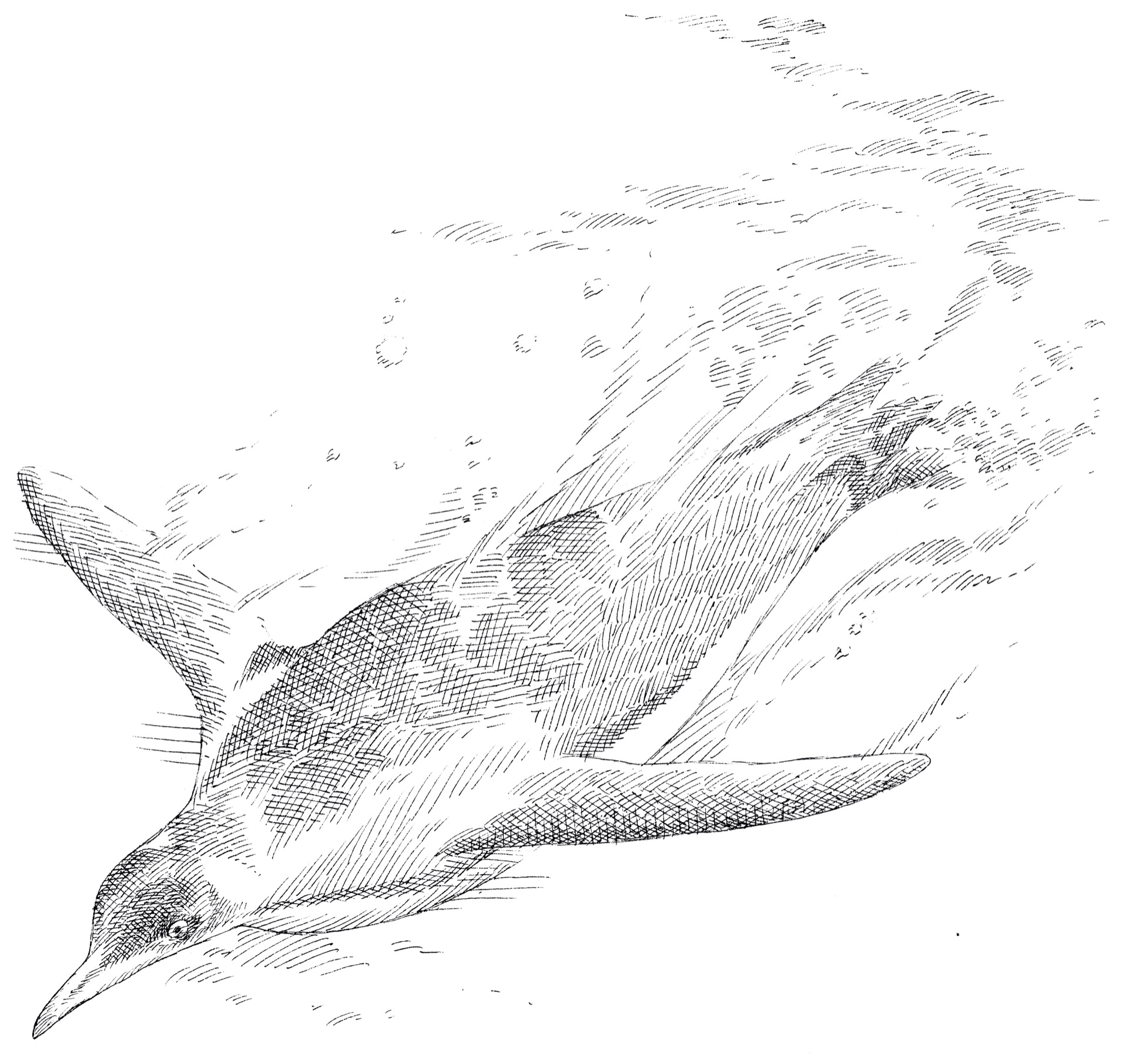
There is the mammal way and there is the bird way. This is one scientists pithy distinction between mammal brains and bird brains: two ways to make a highly intelligent mind.
But the bird way is much more than a unique pattern of brain wiring. Its flight and egg and feathers and song. Its the demure plumage of a mountain thornbill and the extravagant tail feathers of an Indian paradise flycatcher, the solo song of a superb lyrebird and the perfectly timed duets of canebrake wrens, an ospreys hurtling dive toward the sea, and a long-legged herons still, patient eyeing of the dark water.
There is clearly no single bird way of being but rather a staggering array of species with different looks and lifestyles. In every respect, in plumage, form, song, flight, niche, and behavior, birds vary. Its what we love about them. Diversity fascinates biologists. It fascinates birdwatchers, too, driving us to assemble life lists, to travel to far corners of the globe to visit a rare species or jump in the car to spot a vagrant blown in by a storm, to go pishing and whistling into the woods to draw that elusive warbler.
Watch birds for a while, and you see that different species do even the most mundane things in radically different ways. We give a nod to this variety in expressions we use to describe our own extreme behaviors. We are owls or larks, swans or ugly ducklings, hawks or doves, good eggs or bad eggs. We snipe and grouse and cajole, a word that comes from the French root meaning chatter like a jay. We are dodos or chickens or popinjays or proud as peacocks. We are stool pigeons and sitting ducks. Culture vultures. Vulture capitalists. Lovebirds. An albatross around the neck. Off on a wild goose chase. Cuckoo. We are naked as a jaybird or in full feather. Fully fledged, empty nesters, no spring chicken. We are early birds, jailbirds, rare birds, odd birds.
As biologist E. O. Wilson once said, when you have seen one bird, you have not seen them all.
This is certainly true for behavior. Take white-winged choughs. Australians say its easy to fall in love with these birdsand it is. Theyre adorable, charismatic, gregarious, comical: lined up on a narrow tree branch, six or seven red-eyed puffs of black feathers, tenderly preening one another in a pearl-like strand of endearment and affection. Clumsy fliers, they prefer to walk everywhere, swaggering through dry eucalypt woodlands with their heads strutting backward and forward like a chickens. They pipe and whistle and wag their tails like puppies. Theyre fond of playing follow-the-leader or keep-away, rolling over one another to win possession of a stick or a slip of bark. About the size of a crow but slimmerblack with elegant white wing patches and an arched billthey live in stable groups of four to twenty birds and are always, always found in clusters or huddles or lines. Like a tight-knit family, they do everything together, drink, roost, dust bathe, play, run in wide formation like a football team to share a food discovery. Together they build big bizarre nests of mud (or emu or cattle dung if theyre in a pinch) set on a horizontal branch, queuing up on the limb, waiting their turn to add their bit of shredded bark, grass, or fur soaked with mud to the rim of the nest. Together they brood, guard, and feed the young. Members of family groups are rarely more than five or ten feet apart. I once saw three fledglings jammed together on the ground like the three wise monkeys, see no evil, hear no evil, speak no evil.
And yet theres a darker side to choughs, especially if the weather turns bad. They squabble and fight, one group pitted against another. Larger groups gang up on smaller groups, flying at them and pecking viciously, dislodging eggs from nests, and nests from trees. They are known to go on violent crime sprees, ruining the nesting efforts of numerous other groups. One bird was observed picking up eggs in its bill one at a time and tossing them to the ground. Perhaps most unsettling, warring choughs do something few animals apart from humans and ants do: They forcibly kidnap and enslave the young from other groups.
This is a book about the range of surprising and sometimes alarming behaviors that birds perform daily, activities that firmly, sometimes gleefully, reverse conventional notions about what is normal in birds and what we thought they were capable of.
Lately, scientists have taken a new look at behaviors they have run past for years and dismissed as anomalies or set aside as abiding mysteries. What they have found is upending traditional views of how birds conduct their lives, how they communicate, forage, court, breed, survive. Its also revealing the remarkable strategies and intelligence underlying these activities, abilities we once considered uniquely our own, or at least the sole domain of a few clever mammalsdeception, manipulation, cheating, kidnapping, and infanticide, but also ingenious communication between species, cooperation, collaboration, altruism, culture, and play.
Some of these extraordinary behaviors are conundrums that seem to push the edges of, well, birdness: a mother bird that kills her own infant sons, and another that selflessly tends to the young of other birds as if they were her own. Young birds that devote themselves to feeding their siblings, and others so competitive that theyll stab their nest mates to death. Birds that create gorgeous works of art, and birds that wantonly destroy the creations of other birds. Birds like the white-winged chough that contain their own contradictions: one murderous bird that impales its prey on thorns or forked branches but sings so beautifully that composers have devised whole compositions around its songs; another with a reputation for solemnity that is strongly addicted to play; and another that collaborates with one specieshumansbut parasitizes another in gruesome fashion. Birds that give gifts and birds that steal, that dance and drum, that paint their creations or paint themselves. Birds that build walls of sound to keep out intruders, and birds that summon playmates with a special calland may hold the secret to our own penchant for playfulness and the evolution of human laughter.
Font size:
Interval:
Bookmark:
Similar books «A New Look at How Birds Talk, Work, Play, Parent, and Think»
Look at similar books to A New Look at How Birds Talk, Work, Play, Parent, and Think. We have selected literature similar in name and meaning in the hope of providing readers with more options to find new, interesting, not yet read works.
Discussion, reviews of the book A New Look at How Birds Talk, Work, Play, Parent, and Think and just readers' own opinions. Leave your comments, write what you think about the work, its meaning or the main characters. Specify what exactly you liked and what you didn't like, and why you think so.

